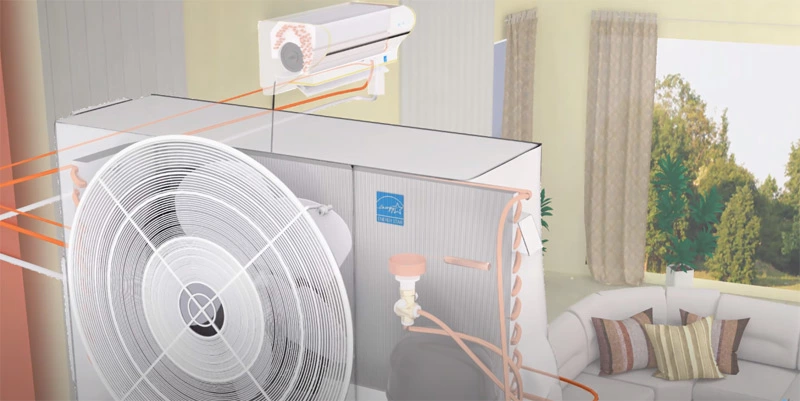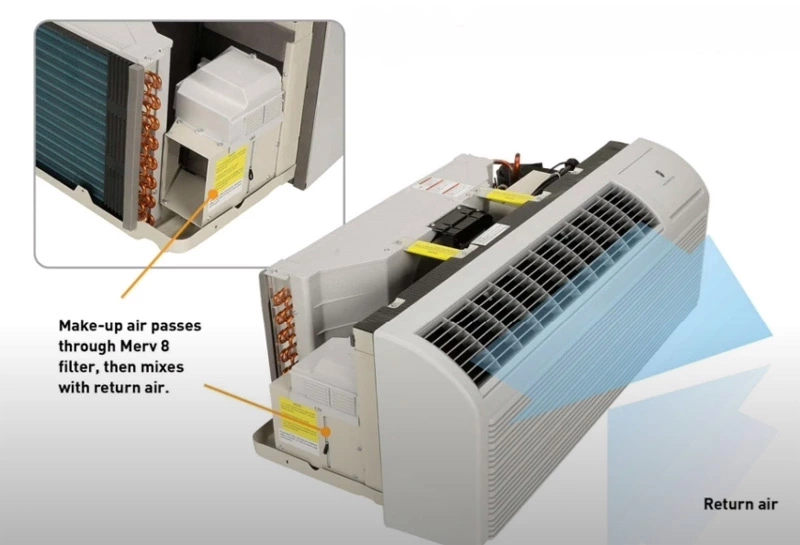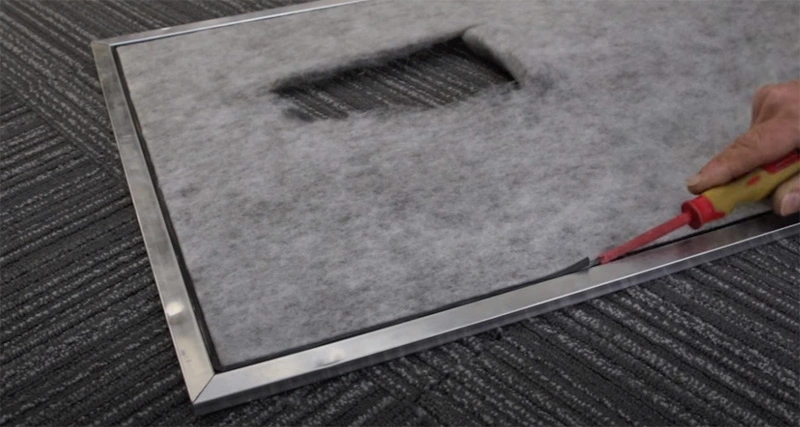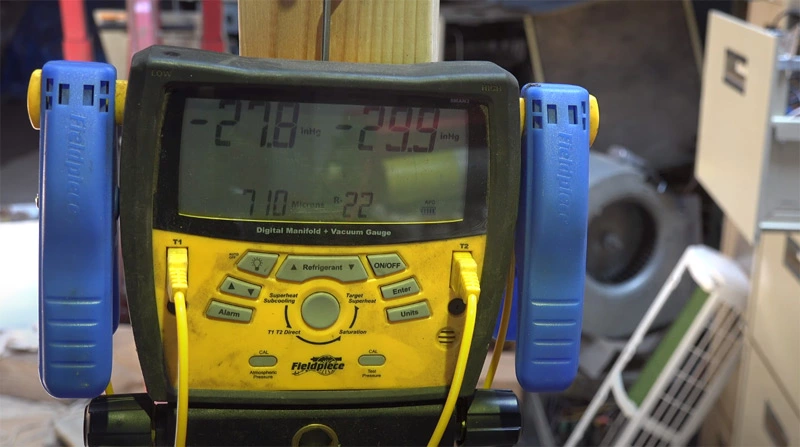You know your AC system keeps your business or home cool in the warm summer months, but have you ever wondered how aircon work? One amazing fact you might not be familiar with is that your AC and your refrigerator work similar. The key difference is your refrigerator chills a little, insulated area, and an AC keeps your office, home, or commercial area at a relax temperature.
Air conditioners are 1 part of the central cooling and central heating system that draws warm energy from outside of the home and transfers it. Just put the air conditioner in both a business and house is a central cooling and heating system that provides chill air via the sheet metal duck work by providing through a process that draws out the hot air inside, removing the heat, which is replaced by the chill air.
The full process of making the air in your property a relaxed temperature is based on a very easy scientific principle.

How does an air conditioner work step by step
How do air conditioners work is actually similar to a refrigerator. The only difference between them is that a refrigerator will chill a little, insulated area, while an AC will cool your full room, office, or home.
Your AC works by moving a refrigerant or coolant via 4 steps:
- Compression
- Expansion
- Condensations
- Evaporation
Through the 4 key components of your unit:
- Compressor
- Expansion valve
- Condenser
- Evaporator
Note: Some types of air conditioner may also have air conditioner fins and air conditioner pads
An AC system uses chemicals with low boiling points (known as refrigerants) that change form gas to liquid form and back again. This cycle emits and absorbs heat, cooling areas that you need, and expelling warm as exhaust. That is why the central chilling system has outside units, and all portable AC need to be vented outside.
When the refrigerant begins, it enters the compressor as a gas, where it is compressed, raising the temperature of that refrigerant. Then, the high-force gas moves to the condenser, where the refrigerant fast moves via fins where the heat is radiated away, changing the gas into a liquid, getting rid of heat fast and efficiently. That liquid then targets the expansion valve, both pressure and temperature reduce. This is where the chilling effect comes in.
In the end step, an aircon refrigerant moves over an evaporator, generally a place with a big surface area, that soak up heats from an inside area and sends outside. A fan generally used to circulate the chill air that forms around an evaporator. As the name describes, the liquid refrigerant then changes back into a gas, moves back to the compressor to begin the cooling or heating cycle.
The cycle goes on until the temperatures in your office or home gets the wanted point. Once the thermostat in the AC notices that the temperature in the home has reached the wanted point, it mechanically shut down the aircon, only restarting when the temperature replaces.
Types of air conditioners
You are going to learn about the classification of air conditioners in this article. The following are the types of air conditioning system:
- Comfort air conditioning system
- Industrial air conditioning system
- Winter air conditioning system
- Summer air conditioning system
- Year-round air conditioning system
- The unitary air conditioning system
- Central air conditioning system
We will look about these in detail one by one. Comfort air conditioning system, the air is brought to the required dry bulb temperature and relative humidity for human health comfort and efficiency if sufficient data required is not available
Then it is assumed to be 21 degrees celsius dry bulb temperature and 50 relative humidity. Example in homes, offices, shops, restaurants, theaters, hospitals, schools etc are using air conditioning systems to give comfort to people.
Industrial air conditioning system, the inside dry bulb temperature and relative humidity of the air is kept constant for working of the machine and for the manufacturing process.
Textile mills, paper mills, machine part, manufacturing plants, tool room, photographic etc are using this type of air conditioning systems according to the season of the year.
Winter air conditioning system, the air is burnt and heated which is generally followed by humidification on the screen you can see. A schematic of winter air conditioning system, the outside air flows through a damper and mixes with the recirculated air. The mixed air passes through a filter to remove the dirt dust and impurities the air. Now passes through a preheat coil to prevent the possible freezing of water and to control the evaporation of water in the humidities.
After that, the air is made to pass through a reheat coil to bring the air to the designed dry bulb temperature. Now the conditioned air is supplied to the conditioned space by a fan from the conditioned space. A part of the air is exhausted to the atmosphere by the exhaust fans. The remaining part of the used air is again conditioned and this will repeat again and again.
Summer air conditioning system, the outside air flows through the damper and mixed with recirculated air, which is obtained from the conditioned space. The mixed air passes through a filter to remove the dirt dust and impurities the air. Now passes through a cooling coil. The coil has a temperature much below the required dry bulb temperature of the air in the conditioned space.
The cooled air passes through a perforated membrane and loses its moisture in the condensed form which is collected in the sump. After that, the air is made to pass through a heating coil which heats the air slowly. This is done to bring the air to the designed dry bulb temperature and relative humidity.
Now the conditioned air is supplied to the conditioned space by a fan from conditioned space. A part of the used air is rejected to the atmosphere by the exhaust fan. The remaining air is again conditioned and this repeated for again and again.
The outside air is sucked and made to mix with recirculated air to make for the loss of conditioned air through exhaust fan from the conditioned space.
Year-round air conditioning system have equipment for both the summer and winter air conditioning schematic. The outside air flows through the damper and mixed with the recirculated air. The mixed air passes through a filter to remove dirt dust and impurities in summer air conditioning system.
The cooling coil operates to cool the air to the desired value. The dehumidification is obtained by operating the cooling coil at a lower temperature than the dew point temperature.
In winter air conditioning system, the cooling coil is made in operative and the heating coil operates to heat the air. The spray type humidifier is also used in the dry season to humidify the air.
According to the arrangement of equipment unitary air conditioning system in unitary air conditioning system, the assembled air conditioner is installed in or adjacent to the space to be conditioned unitary systems. The common type of one-room conditioners sit in a window or wall opening with interior controls.
Interior air is cooled as a fan blows it over the evaporator. The exterior air is heated as a second fan blows it over the conditioner. In this process, heat is supplied from the room and discharged to the environment.
A large house or building may have several such units permitting each room to be cooled separately.
The unitary air conditioning systems are of the following two types:
- Window unit
- Vertical packed units or ptac systems
Typical window unit have a small capacity of 1tr to 3tr and are mentioned through a window or wall. They are employed to condition the air of one room only. If the room is bigger in size then two or more units are used.

Vertical packed units or ptac systems are bigger in the capacity of 5 to 20 tr and are adjacent to the space to be conditioned. This unit is very useful for conditioning the air of a restaurant, bank or small office. Ptac systems are also known as wall split air conditioning systems or ductless systems.
These ptac systems which are widely used in hotels. Have two separate units, the evaporative unit on the interior and the condensing unit on the exterior with tubing passes through the wall and connect them together.
This minimizes the interior system footprint and allows each room to be adjacent independently. Ptac system may be adapted to provide heating in cold weather either directly by using an electric strip gas or other heaters or by reversing the refrigerant flow to heat the interior and draw heat from the exterior air converting the air into a heat pump while room air conditioning provides maximum flexibility when cooling rooms.
It is generally more expensive than a central air conditioning system.
Central air conditioning system is the most important type of air conditioning system. It is used when the required cooling capacity is 25 tr or more. It is used when the airflow is more than 300 meter cube per minute or there are different zones in a building.
Air conditioner filters

The most vital maintenance job that will make sure the efficiency of your AC is to routinely change or clean its filters. Clogged, dirty filters stop normal airflow and decrease systems work significantly. With general airflow blocked, the air that avoids the filter may carry dirt straight into the coil evaporator and impair the coil heat-gripping capacity. Filters also placed someplace along the return ducts length. Common filter places are in ceilings, walls, furnaces, or in the AC itself.
Some kinds of filters are able to be used again, others must be changed. They are accessible in a big range of types and properties. Clean or change your AC system filters or filters every month or 2 during the chilling season. Filters may require more continued to focus if the AC is in continued use, due to dusty situations, or you have beautiful pets in the home. If you use a disposable type filter, it is forever wise to keep many spares within the home.
Moisture removal

In addition to chilling internal areas, AC also offers dehumidification. The real intent behind the invention of the AC was to remove humidity from industrial locations, with the chilling of the air considered a secondary effect. The removal of moisture during AC unit work happens when the relatively hot air of the building inside is pulled across the chill evaporator coils.
According to science, that hot air can hold more water than chill air, the cooling of the building air as it gets in touch with the evaporates coils causes it to release wetness which forms as condensation on the coils. This condensation actually drips off and is collected and drained off the building exterior or to a sewer link. A reduction in building moisture tends to better the relax level of the occupants by improving the effectiveness of the body’s natural chilling system. The mixture of humidity removal and temperature reduction defines the conditioning of the air.
Advantages of air conditioners
Now that you know how aircon work, why would you want one?
- An AC system makes sure that your house remains to relax during the hot months. They also decrease the humidity levels in the home, depending on where you live, you might want to consider getting an accompanying humidifier.
- Aircon clean the air inside your home. As an AC draws out hot air, new air is passed via filters that get remove airborne particles like dust and lint. Some filters are able of eliminating microscopic dust as well.
- The air conditioner remain temperature stable. This not just important for more relax living but saves furniture, hardwood floors, musical tools against warping.
- The calm temperature lowers your body temperature, providing you a deeper and more amazing sleep
- The comfort of a chill room keeps a workforce productive – Aircon even help stop your gadgets from overheating
How to use btu to choose aircon size for home use is important anyway if you expect your aircon to rightly cool your home. An air conditioner is too big will run up power costs, while one that is too little will not cool your home rightly.
Curious to know is air conditioner ac or dc?


